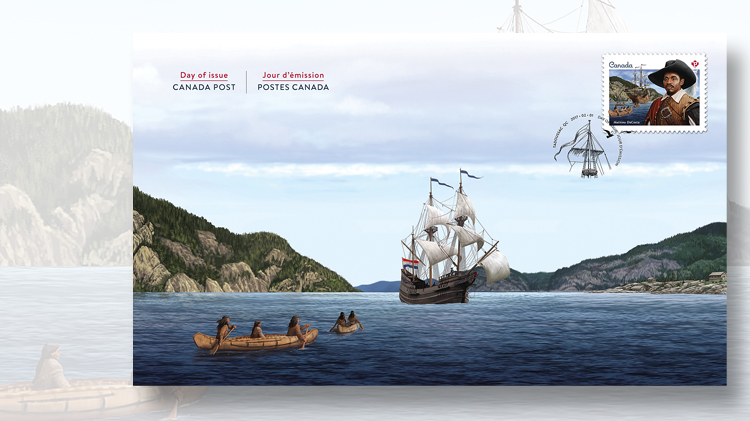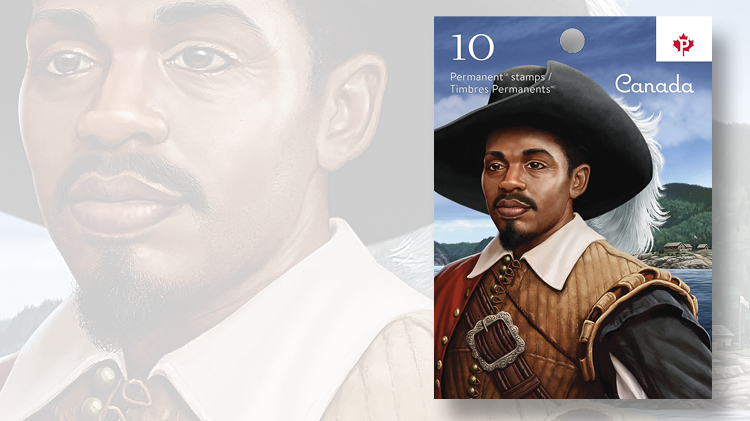World Stamps
The legendary figure on Canada’s newest Black History Month stamp
By Fred Baumann
The latest stamp in Canada Post’s Black History Month series recalls the earliest-known Canadian of African descent, about whom so little is known that there is widespread disagreement even as to his surname.
Canada, like the United States, celebrates Black History Month each February. Canada Post’s Black History Month stamp series began in 2009.
The new nondenominated “P” permanent-rate stamp (85¢) honoring Mathieu Da Costa was issued Feb. 1. In a press release, Canada Post refers to him as a “17th century interpreter believed to be the first person of African descent to arrive in Canada whose name is known today.”
Connect with Linn’s Stamp News:
Sign up for our newsletter
Like us on Facebook
Follow us on Twitter
Da Costa was born in the late 16th century, perhaps in West Africa’s Benin Empire or in the Azores. A free man known for his prodigious talent as a multilingual interpreter, he was employed by French and Dutch traders and explorers, according to the Black History Canada website.
“It was not unusual for Africans to act as translators for Europeans as it had been going on for 100 years before Champlain’s time as Europeans explored their way down the African coast.
“This explains why Da Costa spoke French, Dutch, and Portuguese. But it is a mystery how Da Costa knew how to be an interpreter with the First Nations of America. He might have used ‘pidgin’ Basque (a mixture of Basque and local), commonly used for trade in the Americas. (The Basques of northern Spain were frequent visitors to the fishery along the Atlantic coast.) This dialect was understood by the Mi’kmaq and Montagnais (who lived along the north shore of the St. Lawrence River). But it is also possible that Da Costa had previously spent time in the Americas and had learned the languages of one or more of the Aboriginal peoples.”
Da Costa is believed to have come to Acadia early in the 17th century.
According to Canada Post, “His connection to Canada came in the year 1608 — the year Samuel de Champlain founded the city of Quebec — when Da Costa signed a contract to work for French fur-trader, explorer and governor of Acadia, Pierre Dugua de Mons.”
Dugua is pictured on a 49¢ Canadian stamp (Scott 2044) marking the 400th anniversary of his arrival in Acadia in 2004, part of a joint issue with France.
Like most early historical figures in Canada, no portrait of Da Costa exists. Canada Post reports that stamp designer Andrew Perro and illustrator Ron Dollekamp worked with Canadian historical and military illustrator and storyboard artist Francis Back “to ensure the period clothing and sailing ship reflect Da Costa’s time and socio-economic milieu.”
As with all Canadian stamps issued in 2017, the Da Costa stamp will contain references to Canada’s sesquicentennial that are visible only under ultraviolet light.
Canadian Bank Note printed the self-adhesive stamp by five-color offset lithography in booklets of 10. A total of 1.4 million booklets were printed. The stamp measures 33 millimeters by 25mm.
The 10-stamp booklet is Canada Post order number 414034111.
Also available are 10,000 official first-day covers (414034131, price $1.85) with a pictorial cancellation from Tadoussac, Quebec, at the confluence of the Saguenay and the northern shore of the St. Lawrence River, where historians believe Da Costa may once have come ashore.
These stamps and related items are available here. Stamps and FDCs are available by mail order from Canada Post Customer Service, Box 90022, 2701 Riverside Drive, Ottawa, ON K1V 1J8 Canada; or by telephone from the United States or Canada at 800-565-4362, and from other countries at 902-863-6550.
Canada’s stamps and stamp products also are available from many new-issue stamp dealers, and from Canada Post’s agent in the United States: Interpost, Box 420, Hewlett, NY 11557.
MORE RELATED ARTICLES
Headlines
-
US Stamps
Oct 7, 2024, 3 PMMcMurtrie dismissed as APS education director following Sept. 21 arrest
-
US Stamps
Oct 7, 2024, 12 PMVasiliauskas named president of Mystic Stamp Co.
-
US Stamps
Oct 6, 2024, 5 PMApgar souvenir card available
-
US Stamps
Oct 6, 2024, 4 PMFirst Continental Congress and U.N. stamps receive Scott catalog numbers











